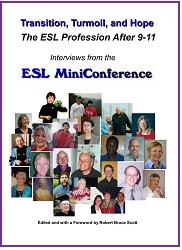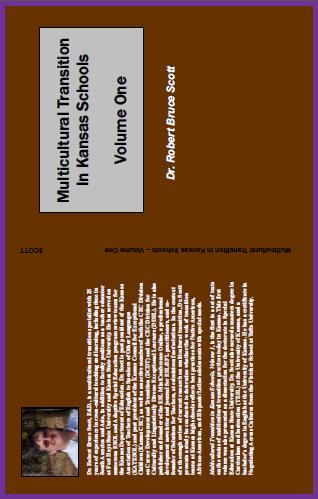
Late
Autumn 2011
Training
Trainers
by David
Hopkins
Post-
Secondary
Outcomes
for
Latinos
by
Robb
Scott, Ed.D.
Expanding
the Goals
of
ESOL
by
Alvino
Fantini,
Ph.D.
![]()
/Index/
/Letters/
/Profiles/
/Search/
/Podcasts/
![]()
Subscribe
for free!


Are NYC (and Kansas) Schools Meeting the Needs of Mexican-American Students?
An Alternative Explanation for High School Dropout Rates
Dr. Robert Bruce Scott is an advocate for multicultural high school students with special needs in Kansas. His 25 years of experience in cross-cultural learning include teaching high school English and journalism at Kickapoo Nation School in Powhattan, Kansas; teaching middle school ESL and advising the high school yearbook staff at Academia Cotopaxi,
In the span of two weeks recently, the New York Times published articles related to demographic changes associated with increased numbers of Latinos in different parts of the United States. One article, "Hispanics Reviving Faded Towns on the Plains," by Steve Hebert, appeared in the November 13th edition of the Times. Hebert reported that in several southwest Kansas communities the arrival of immigrants with Mexican ancestry has helped small towns survive and prosper again. In another article, "In New York, Mexicans Lag in Education," by Kirk Semple, on November 24, 2011, it was reported that 41 percent of all Mexican immigrants between the ages of 16 and 19 in New York City "have dropped out of school, according to census data."
Growth of the Mexican-American population constituted 56 percent of the total increase on the latest census, in 2010, according to the Pew Hispanic Trust, which also reported this summer that "births have surpassed immigration as the main driver of the dynamic growth in the U.S. Hispanic population" (July 14, 2011).
Previous reports by the Pew Hispanic Trust have cited research suggesting that Latino immigrants are among the most patriotic groups of people in the United States, with a strong belief in the future of the American dream (December, 2002).
Additionally, both of the recent Times articles praised the work ethic of Mexican-American adults; in small towns like Ulysses, Kansas, these immigrants have literally breathed new life into a town that had almost completely disappeared. The children of Latino families are also helping to keep enrollment numbers up so that small-town schools can stay open.
The enormous school system of New York City and the less populated districts in southwestern Kansas have in common the high drop-out rates for Hispanic/Latino students. One remarkable phenomenon was the decrease in numbers of Hispanic/Latino high school students in Liberal, Kansas, from 229 ninth-graders in 2004, to 119 seniors in 2007, a 48 percent drop.
Similar trends were observed in enrollment data from the largest three towns in southwest Kansas--Liberal, Garden City, and Dodge City--with 41 percent, 26 percent, and 29 percent drop-offs, respectively, in Hispanic student numbers from ninth grade to 12th grade, during the four year period from 2005 to 2009.
In their 1995 study, Ortiz and Guss interviewed male Hispanic dropouts from Dodge City schools, and found that the number one reason they gave for leaving school was that they "strongly felt the administrators did not want them there any longer" (ERIC ED386671). Many of those former students also reported having sensed from at least one teacher in their high school experience that the teacher did not want them in the classroom, according to Ortiz and Guss.
Beth Harry (2008) suggests that the attitudes of school personnel often have a negative effect on learning outcomes for culturally and linguistically diverse students. The traditionally accepted explanations of poor academic performance, blaming it on poverty, culture, or parents' educational levels, according to Harry, are transformed into "deficit views," with "dis-empowering effects."
Paolo Freire (1970) wrote that "one of the gravest obstacles to the achievement of liberation is that oppressive reality absorbs those within it and thereby acts to submerge [the] consciousness." That is very likely the feeling that is causing too many students of Mexican heritage to drop out of New York and Kansas high schools.
Modern proponents of empowerment theory, such as Hipolito-Delgado and Lee (2007), suggest that educators ought to "become active in the process of liberating the students of marginalized communities by promoting personal empowerment of students, promoting community empowerment, and engaging in activism on behalf of their students."
In a new book, "Multicultural Transition in Kansas Schools," the author provides 10 recommendations for improving post-secondary outcomes for culturally and linguistically diverse adolescents:
A new advocacy group, the Kansas Council for Equity and Access to Transition Services, is sponsoring a campaign in the spring of 2012 to spotlight and celebrate schools and districts in Kansas where transition planning and services for culturally and linguistically diverse adolescents with special needs are aligned with the recommendations listed above. It is hoped that this campaign will reinforce best practices and challenge school communities to become more inclusive and engaged with all students and families from different cultural heritages in Kansas. Perhaps New York City public schools can also look for ways to adjust their curricula to improve equity and access for individuals from a variety of different backgrounds.
2011 ESL MiniConference Online
PDF conversion by PDF Online
![]() an American school in Quito, Ecuador; teaching English as a Second Language to college and adult students in Ecuador, Japan, New York, Kansas, and Colorado; and writing career-development curricula with a bilingual component as director of adult transition services at Lamar Community College, in Lamar, Colorado. Dr. Scott has served on teacher education faculty at Fort Hays State University and Kansas State University. He is past president of Kansas TESOL and past president of the Kansas Council for Exceptional Children (Kansas CEC). He served on the executive committee of the Tokyo chapter of the Japanese Association of Language Teachers (JALT). Dr. Scott also serves on ESOL and Adaptive Special Education program review teams for the Kansas Department of Education.
an American school in Quito, Ecuador; teaching English as a Second Language to college and adult students in Ecuador, Japan, New York, Kansas, and Colorado; and writing career-development curricula with a bilingual component as director of adult transition services at Lamar Community College, in Lamar, Colorado. Dr. Scott has served on teacher education faculty at Fort Hays State University and Kansas State University. He is past president of Kansas TESOL and past president of the Kansas Council for Exceptional Children (Kansas CEC). He served on the executive committee of the Tokyo chapter of the Japanese Association of Language Teachers (JALT). Dr. Scott also serves on ESOL and Adaptive Special Education program review teams for the Kansas Department of Education.
2. School personnel advocate for the civil rights of undocumented students.
3. Parents are treated as equal partners, with effective cross-cultural collaboration between parents and staff.
4. Every education plan at every age incorporates heritage and language data to impact curricular decisions.
5. Cultural and linguistic heritage of the student and family is counted as a strength in developing goals, objectives, and skills.
6. Personal career goals emanate from the student's own interests and family preferences, respecting their heritage.
7. Building administrators establish connections with non-white leaders to be included as speakers, mentors, and role models.
8. Social interaction skills and involvement in self-advocacy are central features of the education plan.
9. Cultural and linguistic heritages are addressed in curricula to build community-participation and communication/social skills.
10. Schools and districts are recognized and honored for excellence and innovation in meeting multicultural needs of students in planning for post-secondary outcomes.
(Scott, R.B., 2011)
Article by Robb Scott, Ed.D.
Contact info for Robb Scott:
DrRobbScott@gmail.com